Future models - BMW - i3BMW outlines i3 sales strategyLeading the charge: This is the first BMW i3 to arrive in Australia. The car won't go on-sale until July next year. One dealer in each major city to sell BMW’s i3, with local launch set for July 20141 Oct 2013 BMW Australia this week gave some insight into how it intends to roll out its cutting-edge ‘i’ sub-brand, starting with the arrival of the i3 pure-electric and range-extender hatch line-up in July 2014. Reflecting the car’s niche status, just one dealer from each major capital city will be appointed as official i-car dealers, although BMW’s entire network will be trained to service and maintain the cars. BMW Australia managing director Phil Horton told GoAuto the company was yet to decide which dealers would be appointed, but said inner-city sites would be the best candidates considering the cars’ key demographic of middle-aged, tech-savvy and well-to-do clientele. Sydney, Melbourne, Brisbane and potentially Perth will be first cabs off the rank, with Canberra and Adelaide hot on their heels. The chosen sites will install special plinths on-site, but will not be required to develop a standalone showroom. While the showrooms will sell only the i3 from launch, each will undergo swift expansion soon after, with the i8 plug-in coupe – dubbed the “new wave supercar without a hint of irony” – due Down Under around December 2014, and additional ‘i’ models confirmed for a later date. As we reported from the Frankfurt motor show last month, BMW has trademarked the badges i1 through to i9, a sure sign it intends to cover more bases with the sub-brand. Despite the launch of the i3 still being about nine months away, BMW’s Australian subsidiary air-freighted a pre-production vehicle to generate awareness and commence its local publicity in earnest. GoAuto was among a number of outlets to do a walk-around with the vehicle this week. The company is keeping quiet on local pricing, although the car’s hi-tech, ground-up carbon-fibre and aluminium construction and Australian versions’ higher levels of standard equipment than in Europe points to premium positioning above rivals such as the Holden Volt and Nissan Leaf. Expect pricing to kick off from close to $70,000, with a premium for the optional range-extender hybrid. BMW says early interest between the pure EV and the range-extender, which uses a BMW motorcycle engine to generate battery charge, thereby doubling effective range, is about 50/50. The company will also sell circa-$1500 wallboxes – household 32A fast-chargers – and might offer internal combustion lease cars to owners for up to 10 days per year if they have a long road trip in mind: although, as the company says, most ‘i’ owners will have an IC car in the garage already. The EV i3 can travel about 160km between charges with careful driving, while the range-extender can manage about 300km. A recharge may take 11 hours at home, though a wallbox charger cuts this to six hours, and a DC fast-charger gets the job done in only 25 minutes. BMW Australia’s general manager of marketing Toni Andreevski said early interest has been substantial, with some 2000 expressions of interest, and a few keen adopters even plonking down deposits without final pricing. At the local event today, Mr Horton spoke of the potential for the ‘i’ brand here, despite our relative lack of super-high-density urban areas – but also of the roadblocks holding back growth of electrified vehicles in general compared to Europe and parts of the US and Asia. “Australia does not have any ‘megacities’, defined as cities with population of 20 or 25 million people,” he said. “The entire population of the country is not a megacity. “But we clearly believe there is potential for the brand here. It’s designed to address a whole host of issues, with traffic congestion in Melbourne in Sydney. There are opportunities for us to sell the relatively limited number of vehicles we sell in the first generation.” The launch, said Mr Horton, would also “sharpen” existing perceptions of BMW as an innovative brand. The ‘i’ cars bring to the table a host of new developments, from their radical bodyshells made of carbon-fibre reinforced plastics, their recycled cabin materials and their ‘holistic’, energy-efficient means of production in a wind-powered German factory. However, the lack of wider federal support for EV or hybrid cars here is a point of contention for more than just BMW, though Mr Horton today canvassed some possible ideas on how to incentivise the spread of such vehicles, taken from those applied in Europe. “This car, for instance, would not attract a congestion levy in the UK (Mr Horton’s country of origin), and would receive a government levy of 5000 pounds, which effectively come off the list price,” he said. “Even if we could see something in Melbourne or Sydney with EVs in general not attracting roll charges, which would be easy to implement and give customers an instant benefit. Also, there could be dedicated parking spaces.” The lack of public charging infrastructure here, while cited by several companies as a key stumbling block, is less of an impediment, says BMW. According to its research, only 2-3 per cent of EV owners charge publicly, with most plugging their car in overnight at home instead. Billed as the first “ground-up” EV, the i3 uses has an aluminium platform with built-in lithium-ion batteries, covered by a carbon-fibre bodyshell that saves around 350kg over the weight of steels. The VW Golf-sized hatch weighs a featherweight 1195kg. The 125kW/250Nm electric motor weighs 50kg and punts car from zero to 100km/h in 7.2 seconds, the same as a Mini Cooper S. Between 80-120km/h, it is faster than a BMW 135i. The motor is situated over the rear axle for 50:50 weight distribution. The range-extender includes a 25kW 650cc motorcycle engine mounted next to the electric motor, but unlike a plug-in hybrid, the IC unit acts as a generator for the batteries rather than a power source to the axle. This is the same setup as the Holden Volt. Design features include pillar-less ‘suicide’ doors, U-shaped headlights and tail-lights with daytime LEDs. From a practicality point-of-view, the four-seat cabin has a high driving position, a pair of hi-res LED displays, 250 litres of cargo space (1100L with the back sets folded).  Read more24th of September 2013  Smart cars to miss a few connectionsAustralia throws up a few problems for new generation of connected cars11th of September 2013  Frankfurt show: BMW flicks switch on production i8BMW’s plug-in i8 true to concept after 32-million-kilometre technology gestationi3 pricing
Motor industry news |
Click to shareBMW modelsResearch BMW i3 pricing
Motor industry news |
























Facebook Twitter Instagram